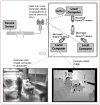Measuring Patient Mobility in the ICU Using a Novel Noninvasive Sensor
- PMID: 28291092
- PMCID: PMC5697716
- DOI: 10.1097/CCM.0000000000002265
Measuring Patient Mobility in the ICU Using a Novel Noninvasive Sensor
Abstract
Objectives: To develop and validate a noninvasive mobility sensor to automatically and continuously detect and measure patient mobility in the ICU.
Design: Prospective, observational study.
Setting: Surgical ICU at an academic hospital.
Patients: Three hundred sixty-two hours of sensor color and depth image data were recorded and curated into 109 segments, each containing 1,000 images, from eight patients.
Interventions: None.
Measurements and main results: Three Microsoft Kinect sensors (Microsoft, Beijing, China) were deployed in one ICU room to collect continuous patient mobility data. We developed software that automatically analyzes the sensor data to measure mobility and assign the highest level within a time period. To characterize the highest mobility level, a validated 11-point mobility scale was collapsed into four categories: nothing in bed, in-bed activity, out-of-bed activity, and walking. Of the 109 sensor segments, the noninvasive mobility sensor was developed using 26 of these from three ICU patients and validated on 83 remaining segments from five different patients. Three physicians annotated each segment for the highest mobility level. The weighted Kappa (κ) statistic for agreement between automated noninvasive mobility sensor output versus manual physician annotation was 0.86 (95% CI, 0.72-1.00). Disagreement primarily occurred in the "nothing in bed" versus "in-bed activity" categories because "the sensor assessed movement continuously," which was significantly more sensitive to motion than physician annotations using a discrete manual scale.
Conclusions: Noninvasive mobility sensor is a novel and feasible method for automating evaluation of ICU patient mobility.
Conflict of interest statement
The remaining authors have disclosed that they do not have any potential conflicts of interest.
Figures


References
-
- Lord RK, Mayhew CR, Korupolu R, et al. ICU early physical rehabilitation programs: Financial modeling of cost savings. Crit Care Med. 2013;41:717–724. - PubMed
-
- Kayambu G, Boots R, Paratz J. Physical therapy for the critically ill in the ICU: A systematic review and meta-analysis. Crit Care Med. 2013;41:1543–1554. - PubMed
-
- Hashem MD, Nelliot A, Needham DM. Early mobilization and rehabilitation in the intensive care unit: Moving back to the future. Respir Care. 2016;61:971–979. - PubMed
-
- Morris PE, Goad A, Thompson C, et al. Early intensive care unit mobility therapy in the treatment of acute respiratory failure. Crit Care Med. 2008;36:2238–2243. - PubMed

